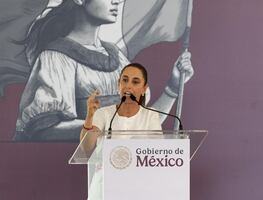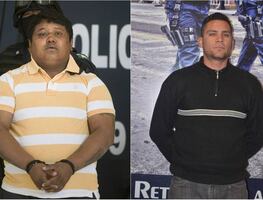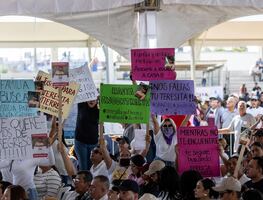Más Información

Osiel Cárdenas, exlíder del Cártel del Golfo, recibe auto de formal prisión; enfrentará juicio por homicidio

Jóvenes mexicanos pasan más de 2 mil horas al año en el teléfono; OCDE alerta sobre su impacto en la salud mental

Sergio Gutiérrez Luna destaca aprobación de 25 reformas en la 66 Legislatura; "Un logro histórico para la 4T", señala

Secretario de Agricultura reafirma defensa del maíz blanco; "Seguiremos apoyando la producción nacional no transgénica", afirma

¿Maíz transgénero? Rubén Rocha corrige desliz durante discurso en Sinaloa; destaca importancia del maíz blanco

Sheinbaum asegura apoyo total a Sinaloa para enfrentar violencia; "Nunca los vamos a dejar solos, aquí está la presidenta"
Rogelio Hernández began to work in the fisheries of Mexico City at age 12. Over time, he wanted to be a fisherman. He enjoyed working with fish and seafood every day.
Four years later, he traveled to La Paz, Baja California, where he learned to catch lobsters and crabs using traps. He came of age hopping from port to port; he traveled across the Pacific, the Gulf of Mexico, and the Caribbean. In Veracruz, he met “La Paloma,” who taught him how to cast a net. He learned something about fishing in all the ports he set foot on.
Despite his eagerness to learn more about the sea, from the late 60's until the early 70's, he experienced first-hand the poverty of fishing ports , mainly those in the South of Mexico. They didn't have tools there, vessels, or infrastructure, recalls a 57-year-old Rogelio, now a chef.
Then came an era of abundance with the subsidies granted during the José López Portillo administration (1976-1982). As time went by, fishermen learned to depend on subsidies and, given the lack of a strategy, they began to administer the fishing areas of the country unevenly.
Inciativa
dataMares
, an alliance between scientists and journalists, reveals in this second feature for EL UNIVERSAL , that the greatest percentage of fishing subsidies are monopolized by the Northwest – Baja California, Baja California Sur, Sinaloa, and Sonora, mainly by the latter two states – accounting for the 66% of the over MXN$ 7 billion granted in subsidies by Mexico's National Aquaculture and Fishing Commission ( CONAPESCA ).
Sonora and Sinaloa are the kings of the “bad and ugly” subsidies , according to the subsidy classification of international economists regarding the grants which do not contribute to a sustainable (economic, ecologic, and social) development. For fuel alone, fishermen of this region received, between 2008 and 2015, over MXN$ 1 billion. Almost 17 years have passed since Mexico signed the Doha Program to remove these subsidies and this is a sign of a distribution without a strategy.

(Fishermen - Photo: Iniciativa dataMares)
Inequality
Subsidies are part of the Program for the Promotion of Aquaculture and Fisheries Productivity of CONAPESCA, an agency part of the Ministry of Agriculture, Livestock, Rural Development, Fisheries and Food ( SAGARPA ).
At a regional level, 66% of subsidies were granted to the northwestern states of Baja California, Baja California Sur, Sonora, and Sinaloa, which are part of the Pacific and the Gulf of California – production leaders at a national level with an average of 12,000 tonnes per year .
In contrast, the Gulf of Mexico – Tamaulipas, Tabasco, Campeche, and Yucatán – received only 23% and their average production is 4,160 tonnes per year. Nevertheless, the percentage of beneficiaries in both regions was similar, with 39% and 37%, accordingly, which means that there are fewer fishermen in the Northwest.
Sinaloa and Sonora received 59% of the total and have 26.6% and 7.2% beneficiaries, respectively. The capacity of Sinaloa's artisanal fishing fleet is higher than that of Veracruz and yet it still it receives 7.5 times more funds . This is an example of how there are states that receive a greater amount of resources for a fewer number of beneficiaries.
Researcher Miguel Ángel Ojeda, of the Autonomous University of Baja California Sur, points out that authorities do not possess the tools to supervise a fair distribution capable of strengthening the development of our coasts.
In a study on subsidies for engines and fuel conducted in three ports part of the Magdalena-Almejas (Baja California Sur) Bay complex, Ojeda and his team found that despite Chale Port, located in La Paz, having the most adverse socioeconomic conditions in the Bay, it was the place were fewer subsidies were granted.
Oaxaca
and Guerrero , despite being two of the poorest states according to the National Council for the Evaluation of Social Development Policy, only receive 2.8% of the subsidies. Ojeda mentions that the resources aren't necessarily given to the least developed communities nor to the ones living in the most underprivileged conditions.
Fisherman Julio López of San Carlos Port, Baja California Sur, accuses that the larger licensees “get all the supports [subsidies] for engines, navigators, video probes, radios, antennas….and us, the free fishermen, we buy the used equipment they pawn.”
Enrique Sanjurjo, Coordinator of Politics and Development for the World Wildlife Fund (WWF) Mexico, highlights that “the way in which they manage things favors businessmen within the fishing sector with resources, rather than the social sector.”
The “Bad and Ugly” of the Northwest
The subsidies concept which receives the most funds is fuel (marine diesel and riverine fuel), accounting for the 38%, according to exclusive numbers of the Iniciativa dataMares. This concept, out of the eight available, is considered the “bad and ugly.”
In the first article of EL UNIVERSAL, published yesterday in this newspaper, it was explained that international economists classify subsidies as “good” when they focus on productivity without exceeding established catches; as “bad" when there is no control over fishing activities; and “ugly,” when the results are almost invisible.
Among the 17 coastal states, Sonora and Sinaloa not only receive the greatest number of subsidies but they are also the leaders in “bad and ugly” fuel subsidies, accounting for 60.3% of the total, the equivalent to MXN$ 1.7 billion. These are the two states with the highest recognition at a national level due to their production, to the extent that the headquarters of CONAPESCA are located in Mazatlán, Sinaloa.
According to the books of CONAPESCA of 2006-2014 – the ones of the current administration haven't been published – these two states produce 548,000 and 286,000 tonnes, on average, of fish and seafood per year, while Guerrero – Mexico's third poorest country – only receives fuel subsidy for 0.05%.
Black Market
In Mexico, the way to obtain subsidies for fishing is through permits . Fishermen of the Northwest report that people who aren't part of the communities have these documents and sell them or rent them. Because of this situation, resources aren't given to the right people due to the deficient controls of CONAPESCA, according to the experts consulted.
Therefore, there is an illegal sale of fuel cards that authorities are subsidizing, which generates a black market. There is also a situation in which companies fake catch records to keep their grants.
“It becomes a vicious cycle: they go to the Fisheries Office and ask to be lent a hand,” says Miguel Ángel Cisneros, a researcher at the National Institute of Fisheries and Aquaculture ( INAPESCA ).
In the 367 case files reviewed by the Superior Audit Office, in 2014 it was determined that 50.7% “didn't meet at least one of the requirements established in the operation regulations,” and CONAPESCA granted the subsidies regardless.
“It had an inadequate design and a deficient operation since it encountered difficulties in effectively focusing and capitalizing on the fishing economic units which need it, thus, it limits production increase and fails to mitigate the stagnation of the of the fishing and aquaculture industry.”

(Fishing vessels - Photo: @dataMares)
A Tide of Opacity
Out of the MXN$ 7 billion allocated for subsidies (2008-2015) analyzed by dataMares, fishing authorities have data on beneficiaries, localities, and assigned sums. However, latest official numbers of 2015 do not include information on selection criteria, as well as the specific goals and assessments.
While the fishing industry has provided transparency to some data and documents, for Eduardo Rolón, Executive Manager of Causa Natura, this “doesn't necessarily mean that there is relevant information that could help us evaluate the decision-making process.”
According to the Transparency Index of Fisheries Policy in Mexico, in 2017, unlike 2015, CONAPESCA greatly improved in its markers although it backtracked in releasing data.
Octavio Aburto, a researcher at the Scripps Institution of Oceanography in San Diego, U.S., considers that insufficient transparency in granting subsidies may result in authorities fostering a patronage or other “perverse situations,” such as favoring individuals within a community to request favors during election times.
Given this context of opacity, the president of the Fisheries Commission, Senator Ernesto Ruffo Appel, presented last March a platform to reveal concessions and permits to promote sustainable development.
While on the stand, according to Ruffo, it's vital to increase the transparency obligations for the General Law on Sustainable Fisheries and Aquaculture.
A report prepared by Iniciativa dataMares MX has evaluated the work of the government office in areas such as permits and licenses, concessions, subsidies, inspection, and surveillance. Among the recommendations made, this organization urges CONAPESCA to improve its databases with breakdown concepts, as well as to include the cases and effects that justify implementation.
* This article is part of the science journalism project promoted by Iniciativa DataMares (datamares.org), which seeks transparency, dissemination, and understanding of information for decision-making processes regarding the sustainability and conservation of the natural resources of the country.
Article, photography, and video: Enrique Alvarado, Alejandro Melgoza and Andrés M. Estrada
Project Coordinator: Raquel López-Sagástegui
Director of the Marine Program of the Gulf of California: Catalina López-Sagástegui
am/bg/sg





